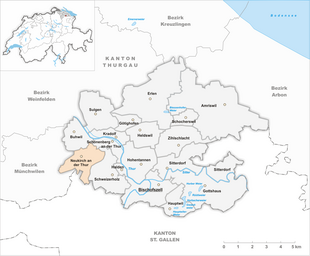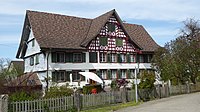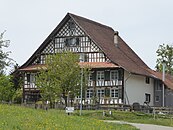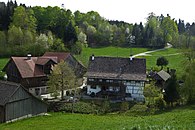Neukirch an der Thur
| Neukirch an der Thur | ||
|---|---|---|
| State : |
|
|
| Canton : |
|
|
| District : | Weinfelden | |
| Political community : | Kradolf-Schönenberg | |
| Postal code : | 9217 | |
| former BFS no. : | 4498 | |
| Coordinates : | 730 716 / 263 829 | |
| Height : | 560 m above sea level M. | |
| Area : | 4.05 km² (local parish ) 14.66 km² (municipality) |
|
| Residents: | 459 (December 31, 2018) | |
| Population density : | 113 inhabitants per km² | |
|
Neukirch an der Thur |
||
| map | ||
|
|
||
Neukirch an der Thur is a village that has belonged to the political municipality of Kradolf-Schönenberg in the Weinfelden district of the Swiss canton of Thurgau since 1996 . The former municipal community Neukirch an der Thur consisted from 1803 to 1995 of the former local communities Buhwil , Halden , Neukirch an der Thur, Schönenberg an der Thur , Schweizersholz and until 1816 from Hohentannen .
The former local and municipal community merged in 1996 with Buhwil, Kradolf and Schönenberg an der Thur to form the new municipality of Kradolf-Schönenberg.
geography
Neukirch an der Thur is located south of the Thur near Sulgen and borders in the south on the St. Gallic municipality of Niederhelfenschwil . Despite the addition to its name , Neukirch does not come directly to the Thur.
The place was able to maintain its rural character despite new buildings. Only about a third of the residents live in the actual village. The rest are spread over a total of 15 hamlets and individual farms. The hamlets Anwachs, Aspenreuti, Bühl and Olmerswil belonged to the former local community of Neukirch an Thur .
history
Neukirch an der Thur was first mentioned in 1291 as Eliswil , in 1296 it was referred to as Sêliswille until the Reformation and in 1520 - after the building of its own church - as Nüwenkilchen . In 1296 Johannes von Schönenberg ceded property in Neukirch to the Bishop of Constance . Neukirch formed together with Schönenberg, Halden , Schweizersholz , Aspenreuti, Olmerswil, Kenzenau, a number of individual farms and with Kradolf since the late Middle Ages the Schönenberg office , which was administered by the episcopal superior bailiff in Bischofszell . This exercised the lower jurisdiction in the office of Schönenberg until 1798 . The reshuffle of the so-called Rotten in the office of Schönenberg ( opening in 1705 ) in local parishes broke out into disputes because of the justice lying on the community property . In 1818 there was then the replacement of justice. In 1815 Neukirch had its own school house.
The pin Pelagi in Bischofszell to 1604 possessed the Kollatur of 1486 created Filialkirche of Sulgen. The Reformation was introduced in 1529. In 1555 St. Pelagi refused any support from the reformed pastor and reintroduced Catholic worship. In 1604 the collection was taken over by Zurich , in 1843 by the canton of Thurgau , and in 1852 by the municipality. The abbot of St. Gallen prohibited Reformed sermons in the neighboring parishes in the 16th century . The Reformed people from the area then attended the church service in Neukirch until 1714, those from Niederhelfenschwil and Zuckenriet up to the present day. The Neukirch church was used simultaneously from 1555 to 1853 .
The mill, mentioned in Neukirch in 1416, lasted until 1916. Up until the 19th century arable and fruit growing was practiced. a. Livestock and dairy farming. In 1865 and 1888, respectively, cheese dairies were established in Olmerswil and Neukirch. A housekeeping school existed in the village from 1891 to 1924. In 1925 Didi Blumer founded a daughters' school for domestic use called Volksbildungsheim Neukirch an der Thur ("Heim Neukirch"), which he ran for thirty years. In 1954, the Volksbildungsheim Neukirch an der Thur association was founded in order to continue its work with conferences, courses and holiday weeks, which later also included the integration of the unemployed. In 2007, due to a lack of demand for traditional adult education, the house was sold and the association dissolved.
During the Second World War, the Hörmooserweiher was drained as part of the cultivation battle for the production of food. At the end of the 1990s, the lowest pond near the saw in Mühletobel was rebuilt and has since served as a water reservoir for the restored saw. In 1990 there were 34 farms with 78 employees in Neukirch.
![]()
On January 1, 1996, the municipalities of Neukirch an der Thur, Buhwil and Schönenberg an der Thur, which had previously belonged to the municipality of Neukirch an der Thur, merged with the municipality of Kradolf, separated from the municipal municipality of Sulgen, and some hamlets separated from the municipality of Schweizersolf to form the political municipality of Kradolf -Schönenberg.
population
| 1850 | 1900 | 1950 | 1990 | 2000 | 2010 | 2018 | |
|---|---|---|---|---|---|---|---|
| Municipal parish | 2546 | 1921 | 1879 | 1997 | |||
| Local parish | 392 | 340 | 357 | 328 | |||
| Locality | 116 | 120 | 459 | ||||
| source | |||||||
Of the total of 459 inhabitants in Neukirch an der Thur in 2018, 35 or 7.6% were foreign nationals. 254 (55.3%) were Protestant Reformed and 102 (22.2%) Roman Catholic.
Attractions
The various half-timbered houses , the Mühletobel with the restored saw powered by water power, the Protestant church and the former "Heim Neukirch" are all worth seeing .
Personalities
- Jakob Stark (* 1958), politician (SVP), government councilor of the canton of Thurgau, member of the Council of States since 2019
- Walter Schönholzer (* 1965), politician (FDP), government councilor of Thurgau
Individual evidence
- ↑ Thurgau in figures 2019 . On the website of the Statistical Office of the Canton of Thurgau (PDF file; 1.8 MB), accessed on April 28, 2020.
- ↑ Swiss land use statistics. Completed on July 1, 1912. Published by the Federal Statistical Bureau. ( Memento from April 12, 2016 in the Internet Archive )
- ↑ a b c d Localities and their resident population. Edition 2019 . On the website of the Statistical Office of the Canton of Thurgau (Excel table; 0.1 MB), accessed on April 28, 2020.
- ↑ a b Population development of the municipalities. Canton of Thurgau, 1850-2000. On the website of the Statistical Office of the Canton of Thurgau (Excel table; 0.1 MB), accessed on April 28, 2020.
-
↑ a b c d e f g h
Erich Trösch: Neukirch an der Thur. In: Historical Lexicon of Switzerland .
These sections are largely based on the entry in the Historical Lexicon of Switzerland (HLS), which, according to the HLS's usage information, is under the Creative Commons license - Attribution - Share under the same conditions 4.0 International (CC BY-SA 4.0). - ↑ a b c d e story. On the website of the municipality of Kradolf-Schönenberg, accessed on November 18, 2019
- ↑ The situation became more and more difficult. in St. Galler Tagblatt (online) from 23 August 2007
- ↑ Locations and Settlements Directory. Canton of Thurgau, 2005 edition . On the website of the Statistical Office of the Canton of Thurgau (PDF; 1.7 MB), accessed on April 28, 2020.
- ↑ Locations and Settlements Directory. Canton of Thurgau, 2012 edition. On the website of the Statistical Office of the Canton of Thurgau (PDF; 3.4 MB), accessed on May 11, 2020.
Remarks
- ↑ with outside courtyards








